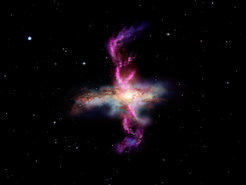Caught in the act: Herschel detects gigantic storms sweeping entire galaxies clean

Copyright: ESA/AOES Medialab
This illustration shows an Ultra-Luminous InfraRed Galaxy (ULIRG) that exhibits massive outflows of molecular gas.
Copyright: ESA/AOES Medialab
In the distant - and therfore younger - Universe, many galaxies show much more activity than our Milky Way today. In commonly accepted evolutionary scenarios gas-rich galaxies merge, which triggers increased star formation ("starburst" galaxies) as well as the growth of supermassive black holes at their centres. This increased activity, however, seems to cease fairly suddenly, effectively stalling star formation and further growth of the black hole in as little as a few million years' time. What processes could be responsible for removing all the raw material powering this activity - around a billion solar masses - in such a (cosmologically) short timespan?
The solution to this riddle could be powerful winds that blow gas outwards from the centre of the galaxy. Powered by newly formed stars, shocks from stellar explosions or by the Black Hole in the galaxy's centre, these storms would remove all the gas supply from the galaxy thereby halting the same mechanisms that produced them in the first place.
"Outflows are key features in models of galactic formation and evolution, but prior to our work no decisive evidence of their active role in such processes had been gathered," explains Eckhard Sturm from the Max Planck Institute for Extraterrestrial Physics (MPE). Sturm led a study of ultra-luminous infrared galaxies with the PACS instrument on board the Herschel space observatory, which revealed massive outflows of molecular gas. Almost all previous observations dealt mainly with neutral and ionised gas, which does not contribute to the formation of stars.
"By detecting outflows in cold molecular gas from which stars are born, we can finally witness their direct impact on star formation," Sturm adds. "Star formation stalls as the gas supply is blown out of the centres of the galaxies with a rate of up to a thousand solar masses per year."

Copyright: ESA/AOES Medialab
Schematic diagram indicating how outflows of molecular gas can be detected in the spectra of galaxies using ESA's Herschel Space Observatory. The astronomers use a particular spectral line of the hydroxyl molecule (OH), which exhibits a very characteristic shape resulting from a combination of emission by the central black hole and by the gas cloud itself: the emission from the accretion disk around the galactic centre has to pass through the gas clouds along the line of sight, in which OH molecules absorb the light - and since these gas clouds are moving towards us, the absorption lines are blue-shifted. At the same time, all gas clouds emit the OH line, especially those which are not on a direct line of sight to the black hole - and as they are moving away from us, this light is red-shifted.
Copyright: ESA/AOES Medialab
However, the observations not only reveal an intermediate stage of galaxy evolution, from disc galaxies with many young stars and a large gas fraction to elliptical galaxies with old stellar populations and little gas. In addition, they can explain another empirical property: The mass of the Black Hole in the centre and the mass of stars in the inner regions of a galaxy seem to correlate. Such a correlation is a natural consequence of the newly found galactic outflows as they remove the common gas reservoir thus inhibiting both star formation and the growth of the Black Hole.
"Herschel's sensitivity enabled us to detect these gigantic galactic storms, and to demonstrate, for the first time, that they may be strong enough to shut down stellar production entirely," says co-author Albrecht Poglitsch, also from MPE and the Principal Investigator of PACS.
The sample of galaxies observed is still too small to pin down the driving force behind these outflows. The first results seem to indicate that the galaxies fall in two categories: starburst-dominated objects loose material of up to a few hundred solar masses per year which is similar to their star formation rate; with velocities of a few hundred kilometres per second these outflows are probably driven by radiation pressure from starbursts or supernovae explosions. Galaxies dominated by the activity of the black hole in their centre loose material at much higher rates, up to a thousand solar masses per year or more; with velocities around 1000 kilometres per second these outflows are probably powered mostly by radiation pressure from the active galactic nucleus. To confirm these first conclusions and study potential trends in the outflow characteristics, the Herschel-PACS observations will continue to cover a much larger sample of galaxies.
Notes to editors: PACS has been developed by a consortium of institutes led by MPE (Germany) and including UVIE (Austria); KU Leuven, CSL, IMEC (Belgium); CEA, LAM (France); MPIA (Germany); INAF-IFSI/OAA/OAP/OAT, LENS, SISSA (Italy); IAC (Spain). This development has been supported by the funding agencies BMVIT (Austria), ESA-PRODEX (Belgium), CEA/CNES (France), DLR (Germany), ASI/INAF (Italy), and CICYT/MCYT (Spain).

![[""] Schematic diagram indicating how outflows of molecular gas can be detected in the spectra of galaxies using ESA's Herschel Space Observatory. The astronomers use a particular spectral line of the hydroxyl molecule (OH), which exhibits a very characteristic shape resulting from a combination of emission by the central black hole and by the gas cloud itself: the emission from the accretion disk around the galactic centre has to pass through the gas clouds along the line of sight, in which OH molecules absorb the light - and since these gas clouds are moving towards us, the absorption lines are blue-shifted. At the same time, all gas clouds emit the OH line, especially those which are not on a direct line of sight to the black hole - and as they are moving away from us, this light is red-shifted.](/14703/original-1310463441.jpg?t=eyJ3aWR0aCI6MzQxLCJmaWxlX2V4dGVuc2lvbiI6ImpwZyIsIm9ial9pZCI6MTQ3MDN9--7d0a56cc38b6132dea0a899f17e4d43f665dc39a)











